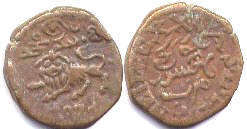Coins of Mysore - catalog with values
Principality of Mysore
Rupee=8 fanam; Fanam=4 chakram; Chakram=32 cash
Krishna Raja Wodeyar III (1810-1868)

20 cash 1837
copper
Coin value ~ 15-20 USD

5 cash 18 (11-33)
copper
Coin value ~ 8-12 USD
Costs of Mysore coins in this catalog approximate and indicated specifically for the coin shown in the picture.
I do not buy or sell coins - this is just a catalog.

